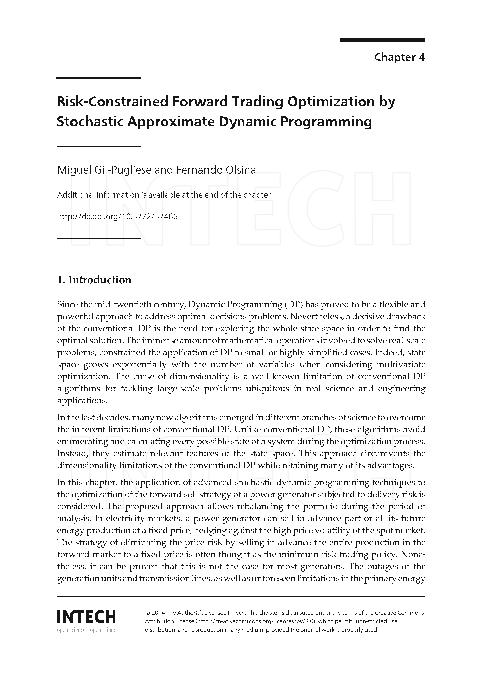Mostrar el registro sencillo del ítem
dc.contributor.author
Gil Pugliese, Miguel Federico

dc.contributor.author
Olsina, Fernando Gabriel

dc.contributor.other
Nezhad, Mohammad Saber Fallah
dc.date.available
2022-06-15T16:48:01Z
dc.date.issued
2014
dc.identifier.citation
Gil Pugliese, Miguel Federico; Olsina, Fernando Gabriel; Risk-constrained forward trading optimization through stochastic approximate dynamic programming; IntechOpen; 2014; 91-124
dc.identifier.isbn
978-953-51-1364-5
dc.identifier.uri
http://hdl.handle.net/11336/159835
dc.description.abstract
Since the mid-twentieth century, Dynamic Programming (DP) has proved to be a flexible and powerful approach to address optimal decisions problems. Nevertheless, a decisive drawback of the conventional DP is the need for exploring the whole state space in order to find the optimal solution. The immense amount of mathematical operations involved to solve real-scale problems, constrained the application of DP to small or highly simplified cases. Indeed, state space grows exponentially with the number of variables when considering multivariate optimization. The curse of dimensionality is a well-known limitation of conventional DP algorithms for tackling large-scale problems ubiquitous in real science and engineering applications. In the last decades, many new algorithms emerged in different branches of science to overcome the inherent limitations of conventional DP. Unlike conventional DP, these algorithms avoid enumerating and calculating every possible state of a system during the optimization process. Instead, they estimate relevant features of the state space. This approach circumvents the dimensionality limitations of the conventional DP while retaining many of its advantages. In this chapter, the application of advanced stochastic dynamic programming techniques to the optimization of the forward sell strategy of a power generator subjected to delivery risk is considered. The proposed approach allows rebalancing the portfolio during the period of analysis. In electricity markets, a power generator can sell in advance part or all its future energy production at a fixed price, hedging against the high price volatility of the spot market. The strategy of eliminating the price risk by selling in advance the entire production in the forward market to a fixed price is often thought as the minimum-risk trading policy. Nonetheless, it can be proven that this is not the case for most generators. The outages of the generation units and transmission lines, as well as unforeseen limitations in the primary energy supply expose generators to delivery risk [1]. Delivery risk considerably modifies the probability distribution of profits, shifting the optimal trading strategy toward a portfolio mixing forward contracts and power sold in the spot market. Because of the size of the probability state space and the limited computing capabilities, the problem of the optimal trading strategy has not a closed form solution and thus, its determination is matter of current study. The increase in computing power and recent developments in Operational Research has brought new insights into the solution of such problems. In the past decade and by virtue of the ever increasing computational power, many methods emerged in different scientific fields with several different names: Reinforced Learning, QLearning, Neuro-Dynamic Programming, etc. All these methods were later brought together in what is currently known as Approximated Dynamic Programming (ADP) [2],[3]. These algorithms resign the exhaustive enumeration and calculation of the space-state typically performed by conventional DP. Instead, they iteratively approximate a function of the space state through stochastic simulation and statistical regression techniques, circumventing the dimensionality problem of DP. Although ADP algorithms are being used in several other fields of science, the application to design optimal trading strategies in power markets has not been proposed so far. In this chapter, ADP techniques are exploited to optimize the selling strategy of a power generator trading in a frictional market with transaction costs. Three available products are considered: selling in the spot market, and/or get involved in quarterly and one-year forward contracts. The objective of the generator is to maximize the expected profit while limiting financial risk. Decisions can be made only at the beginning of each month. At each decision stage, the current trading position can be changed at a cost in order to rebalance the portfolio.
dc.format
application/pdf
dc.language.iso
eng
dc.publisher
IntechOpen

dc.rights
info:eu-repo/semantics/openAccess
dc.rights.uri
https://creativecommons.org/licenses/by/2.5/ar/
dc.subject
APPROXIMATE DYNAMIC PROGRAMING
dc.subject
MONTE CARLO
dc.subject
POWER TRADING
dc.subject
RISK-CONSTRAINED OPTIMIZATION
dc.subject.classification
Estadística y Probabilidad

dc.subject.classification
Matemáticas

dc.subject.classification
CIENCIAS NATURALES Y EXACTAS

dc.title
Risk-constrained forward trading optimization through stochastic approximate dynamic programming
dc.type
info:eu-repo/semantics/publishedVersion
dc.type
info:eu-repo/semantics/bookPart
dc.type
info:ar-repo/semantics/parte de libro
dc.date.updated
2022-06-09T13:33:35Z
dc.journal.pagination
91-124
dc.journal.pais
Reino Unido

dc.journal.ciudad
Londres
dc.description.fil
Fil: Gil Pugliese, Miguel Federico. Consejo Nacional de Investigaciones Científicas y Técnicas. Centro Científico Tecnológico Conicet - San Juan. Instituto de Energía Eléctrica. Universidad Nacional de San Juan. Facultad de Ingeniería. Instituto de Energía Eléctrica; Argentina. Instituto F/elektrische Anlagen & Energiewirtschaft; Alemania
dc.description.fil
Fil: Olsina, Fernando Gabriel. Consejo Nacional de Investigaciones Científicas y Técnicas. Centro Científico Tecnológico Conicet - San Juan. Instituto de Energía Eléctrica. Universidad Nacional de San Juan. Facultad de Ingeniería. Instituto de Energía Eléctrica; Argentina
dc.relation.alternativeid
info:eu-repo/semantics/altIdentifier/url/https://www.intechopen.com/chapters/46367
dc.relation.alternativeid
info:eu-repo/semantics/altIdentifier/doi/http://dx.doi.org/10.5772/57466
dc.conicet.paginas
166
dc.source.titulo
Dynamic programming and bayesian inference, concepts and applications
Archivos asociados
